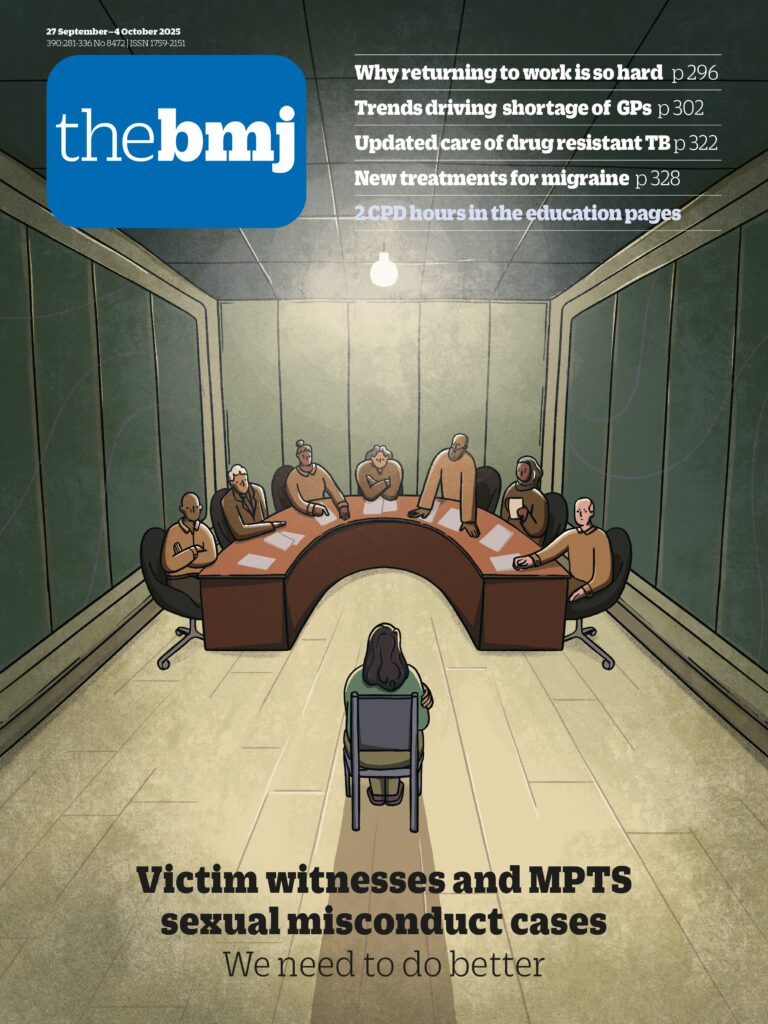- Caroline Dale, tenure track fellow1,
- Louise Kenny, pro vice chancellor and professor of fetal and maternal health2,
- Ranee Thakar, president3,
- Shakila Thangaratinam, professor of women’s health and NIHR senior investigator4,
- Reecha Sofat, Breckenridge chair of clinical pharmacology and therapeutics and NIHR research professor1
1Department of Pharmacology and Therapeutics, University of Liverpool, UK
2Faculty of Health and Life Sciences, University of Liverpool, UK
3Royal College of Obstetricians and Gynaecologists, London, UK
4University of Liverpool
- Correspondence to: L Kenny louise.kenny{at}liverpool.ac.uk
Pregnant women are often excluded from clinical trials, leaving an evidence gap and enabling unsubstantiated claims, write Caroline Dale and colleagues
On 22 September, US president Donald Trump, accompanied by his health secretary Robert F Kennedy Jr, advised against using Tylenol (paracetamol) during pregnancy.1 They inaccurately linked it to an increased risk of neurodevelopmental disorders, including autism and attention deficit hyperactivity disorder (ADHD) in children exposed during pregnancy.
In the United Kingdom, the Science Media Centre brought forward a wide range of leading clinicians and scientists from pharmacology, obstetrics and gynaecology, and neuroscience, all of whom provided clear, robust, and evidence based reassurance on the safety of paracetamol in pregnancy.2 Health agencies and regulators worldwide, including the UK’s Medicines and Health products Regulatory Agency, the European Medicines Agency, and Australia’s Therapeutic Goods Administration, have unequivocally refuted a causal link between the use of paracetamol during pregnancy and childhood neurodevelopmental problems.345 Still, those of us working at the clinical interface were already bracing ourselves for the inevitable fallout.
Paracetamol is one of the most commonly used medications during pregnancy.6 It is considered a safe firstline drug to treat pain and fever in pregnancy based on current evidence.78 This is important because the standard alternative class of drugs for relief of pain and fever, non-steroidal anti-inflammatory drugs (NSAIDs), are known to affect the fetal vascular system adversely. NSAIDs can cause complications such as oligohydramnios and premature closure of the ductus arteriosus.91011
Inhibiting paracetamol use would leave pregnant women with no options for pain relief and control of fever that can be associated with adverse fetal events.12 Unsubstantiated claims about the risk of paracetamol use during pregnancy could discourage women from using one of the few safe medicines available to them. Such messages may also create unnecessary anxiety for pregnant women who need paracetamol and foster unwarranted guilt in mothers of children with neurodevelopmental conditions.
This story highlights another failure of the system—the historic and ongoing underinvestment in women’s health research, particularly in pregnancy. The resulting lack of evidence around medicine use during pregnancy remains a critical and longstanding problem. Currently, three out of four women take one or more medications in pregnancy,13 but there is very little to no evidence to support the use of many medications in pregnant women.14 The care we can offer to pregnant women is severely hampered by a lack of suitable drugs known to be safe and effective for use in pregnancy or during breastfeeding. Despite this overwhelming need, in the last 40 years only three new drugs have been licensed for use in pregnancy—atosiban for premature labour,15 doxylamine/pyridoxine16 for morning sickness, and the respiratory syncytial virus vaccine.17
Pregnant women are almost always excluded from clinical trials, perpetuating an evidence gap that has been highlighted by the current debate. Closing this gap is essential to protect women’s health, provide strong evidence on the safety of medication use during pregnancy, and ensure that risk communication is grounded in robust science. More studies are required to provide women and clinicians with definitive answers on medication use in pregnancy. Studies should include large, prospective biomarker based studies with detailed dose and timing data, sibling comparison, use of routine linked electronic health record data, robust methodologies such as causal inference designs, and the integration of mechanistic work.
We must not repeat the mistakes that followed the now retracted and debunked Andrew Wakefield study on measles, mumps and rubella (MMR) vaccination and autism. Its aftermath illustrates how premature and poorly contextualised risk communication can lead to harm and set back public health efforts and scientific progress by decades. We note with frustration but without surprise, that despite incontrovertible evidence of the safety of MMR, in the same speech on 22 September, Trump sought to reignite this debate.1
In the absence of clear causal evidence, undermining confidence in one of the few safe and effective pain and fever relief drugs in pregnancy risks causing unintended harm. Evidence generation that prioritises pregnant women is a public health imperative. Despite repeated calls for the prioritisation of women’s health research, pregnant women and their babies continue to be denied access to the benefits generated by recent breakthroughs in drug development, with devastating results. If this evidence were available, we would have stronger grounds to defend against unsubstantiated and potentially harmful claims. But given anti-science rhetoric of the current US administration, we would likely still have to defend against unfounded claims.
Footnotes
-
Competing interests: None declared.
-
Provenance and peer review: Not commissioned, not externally peer reviewed.
-
AI declaration: The authors declare that the text and opinions within this article are wholly their own work; there has been no use of artificial intelligence in the preparation of the article.
-
Declaration: RS is an NIHR Research Professor (NIHR303160) and is funded by the NIHR. The views expressed in this publication are those of the author(s) and not necessarily those of the NIHR, NHS or the UK Department of Health and Social Care.

